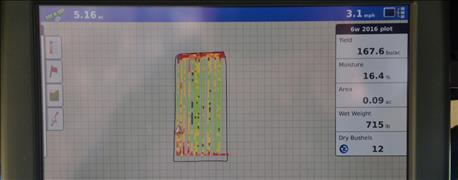
A USDA survey dating back to 2010 indicated a sizable percentage of farms were still without a yield monitor. Of those that had a yield monitor, not all set them up with GPS and mapping capabilities.
No doubt a current survey would show increased use of yield monitors. Here’s a good bet: If you still don’t have a yield monitor, odds are you will within five years.
Why? Because what you can learn from a yield monitor goes way beyond yield data. You can monitor performance of the machine, track moisture levels, and get a feel for where yields are better and where they need improvement.

INSTANT INFROMATION: Your grandpa couldn’t have imagined having this type of information at his fingertips when harvesting with a pull-type International Harvester model 64 combine in 1960.
Here are five things you can learn from a combine yield monitor. Use the snapshot of a yield monitor displayed at the end of this story as a guide. This shot was taken while a Purdue University farm crew harvested a research plot at the Throckmorton research center near Romney.
1. Yield is displayed on the go. While it’s far from the only thing most modern yield monitors can do, it’s perhaps still the most valuable. Note that when this photo was taken, the yield at that instant was 167.6 bushels per acre. Engineers can argue whether that yield is really from the spot it shows on a yield map, or from 50 to 75 feet behind the combine. Compared to 1990 when there was no such thing as a commercial yield monitor, just knowing about what the yield is on-the-go is phenomenal!
2. Moisture level is displayed on the screen. Look below the yield number on the right side of the screen. This corn was testing at 16.4 % moisture. If the monitor is calibrated for moisture, it’s likely very close to the actual moisture content.
3. Follow yield pattern with on-the-go mapping. The map in the center of the screen fills in as the combine moves through the field. This map has gaps because every treatment of one hybrid was harvested before the other hybrid. The two hybrids were positioned across the field in six-row blocks at random. If you look at the bottom of the screen, you can see the monitor tells you it’s running a six-row head.
4. Check on travel speed. In the upper-right corner, the monitor displays the number 3.1. That’s the speed the combine was traveling. Normally this combine runs at about 4 mph, says Pete Illingworth, one of the farm crew who operates the machine. It was running slower on this pass, so that the yield monitor could be calibrated. After running at four speeds, the operator could determine if there was an error and correct for it. Error was minimal.
5. Follow combine performance data and settings. Note the image of the combine in the lower-right corner. Important information about settings of various components and performance are displayed.

About the Author(s)
You May Also Like




